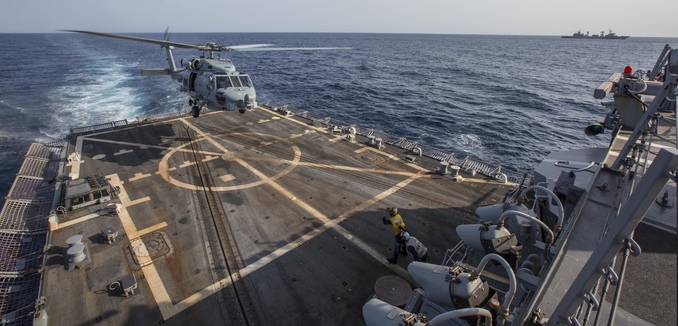Iran-backed Houthi rebels fired two missiles at a U.S. Navy destroyer traveling north of the strategic Bab al-Mandab strait near Yemen on Sunday evening, a U.S. military spokesman said.
The USS Mason was “conducting routine operations in international waters in the Red Sea off the coast of Yemen” when crew members “detected two inbound missiles over a 60-minute period,” Pentagon spokesman Captain Jeff Davis said.
“Both missiles impacted the water before reaching the ship,” Davis added. “There were no injuries to our sailors and no damage to the ship.”
“We assess the missiles were launched from Houthi-controlled territory in Yemen,” he continued. Houthi rebels seized control of the Yemeni government in 2015, prompting a military intervention by a Saudi-led coalition of Arab countries. The United Nations has identified Yemen as a “humanitarian crisis,” reporting that more than 10,000 people, including 3,800 civilians, were killed between March 2015 and August 2016.
The U.S. Navy destroyer was deployed to Bab al-Mandab after a UAE ship was struck and severely damaged by Houthi rockets there last week. The weapons used in that attack were supplied by Iran, American officials told Fox News.
Davis emphasized that the U.S. is committed to ensuring free movement in the Red Sea strait, through which more than 4.7 million barrels of oil passed daily in 2014. “We will continue to take all necessary steps to ensure the safety of our ships and our service members,” he said, but did not indicate whether the military will pursue any specific actions in response to the attack.
In August, Secretary of State John Kerry accused Iran of arming Houthi rebels with missiles and other sophisticated weapons. “The threat additionally posed by the shipment of missiles and other sophisticated weapons into Yemen from Iran extends well beyond Yemen,” he warned. “It is not a threat just to Saudi Arabia; it is a threat to the region, it is a threat to the United States, and it cannot continue.”
Iranian media reported on Monday that Houthi rebels fired a “locally manufactured ballistic missile” that struck an airbase in central Saudi Arabia.
Iran has significantly stepped up its aggressive naval behavior in the Persian Gulf in recent months. Ten American sailors and their two boats were seized by naval forces belonging to the Islamic Revolutionary Guard Corps in January of this year, in violation of international law. Iran portrayed their capture as a victory against the U.S., releasing the sailors after claiming that Washington apologized for the incident. Iran’s supreme leader, Ayatollah Ali Khamenei, called the seizure of the Americans “God’s deed” and issued medals to the commanders involved, while the IRGC announced plans to build a statue to commemorate the incident.
In May, the IRGC’s deputy commander threatened to close the Gulf’s strategic Straits of Hormuz to the U.S. and its allies if they “threaten us,” adding: “Americans cannot make safe any part of the world.”
The U.S. Navy reported in July that there were nearly 300 encounters or “interactions” between American and Iranian naval vessels in the Persian Gulf in 2015. While most of the encounters were not considered to be harassment, the behavior of the Iranian navy was found to be less disciplined than that of other navies. Lt. Forrest Griggs, the operations officer of the USS New Orleans, explained that risks arise from the unpredictable behavior and uncertain intent of the Iranian vessels. “It’s very common for them to come up to within 300, 500 yards of us, and then they’ll turn, or parallel us and stop,” he told Fox.
Vice Adm. Kevin Donegan, the commander of the Navy’s Fifth Fleet, observed in November that Iran’s “malign behavior” at sea had not changed since the announcement of the nuclear deal four months earlier.
[Photo: U.S. Naval Forces Central Command/U.S. Fifth Fleet / Flickr ]




